About this manuscript
Identifying the Prophet’s supplications
ʿUddat al-ḥiṣn al-ḥaṣīn is a collection of some 600 different supplications to God, compiled by the Mamluk-era scholar Ibn al-Jazarī. Most are supposed to recount verbatim the very phrases which the Prophet himself used when he supplicated to God. Given the principal that one’s words offered to God are more likely to be accepted if they are phrased in exactly the same wording of the Prophet, authenticity is a key aspect of the book: readers of ʿUddat al-ḥiṣn al-ḥaṣīn will want to know that the Prophet likely did utter the statements contained between the book’s covers.
Ibn al-Jazarī compiled this book by combing through 25 different hadith collections to find examples of the Prophet's supplications. The source material was thus of varied authenticity: some collections, such as al-Bukhārī’s Ṣaḥīḥ, contained hadith selected under stringent criteria, but others, such as the Muṣannaf of Ibn Abī Shayba, were bulk-collections, containing potentially-inauthentic hadith.
In order to indicate the source for the supplications in ʿUddat al-ḥiṣn al-ḥaṣīn, Ibn al-Jazarī could have written the isnād for each, but he intended the book to be a convenient-sized pocket-volume which anyone could carry as a quick reference for the types of supplications they should make at different times and contexts. Including full isnāds for each of the 600 hadiths would have more than doubled the book’s size, affecting its intended compactness.
To maintain the trappings of authority without actually writing the text of each isnād, various copies of ʿUddat al-ḥiṣn al-ḥaṣīn employed visual annotation strategies. Ibn al-Jazarī assigned an Arabic-letter abbreviation to each of the 25 collections which he consulted, and beside each hadith contained in ʿUddat al-ḥiṣn al-ḥaṣīn, the letter abbreviation corresponding to its original source was added. Where an individual hadith appears in more than one of the 25 source collections, each of the collections in which it is narrated is noted.
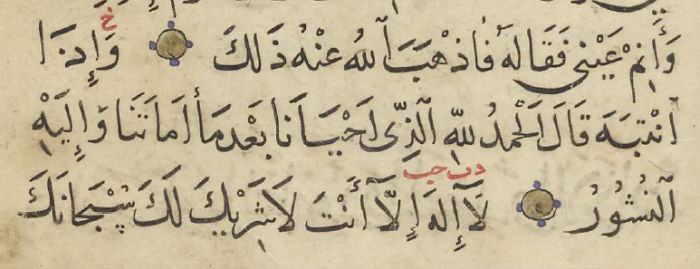
Some hadith are recorded with slight variations in the supplication's precise wording across different hadith collections, e.g. one version of a given supplication might contain more phrases, or the order of phrases might differ between versions. To indicate variance, Ibn al-Jazarī marks multiple annotations: in the Leiden Ms Or. 14.076, the superscript annotation above the beginning of the hadith marks the common source, and where phrases unique to just one source begin, another annotation is marked.
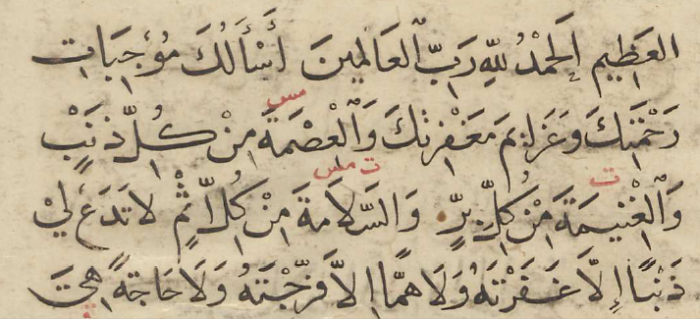
Marking the sources
Ibn al-Jazarī's introduction indicates that he originally devised the abbreviations and inscribed them for each hadith, but subsequent copyists followed his lead with variations, including in the method of representing the abbreviation key. A copy in the Qatar National Library writes the list of abbreviations as a block of text within the book's introductory preamble, whereas Leiden manuscript Or. 14.076 in the frame sets out the sources in a table before the title page (f. 3r/v), while a copy in Berlin (Ms. or. oct. 240 f. 139v) presents a more decorative table at the end of the introduction.
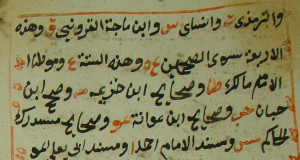

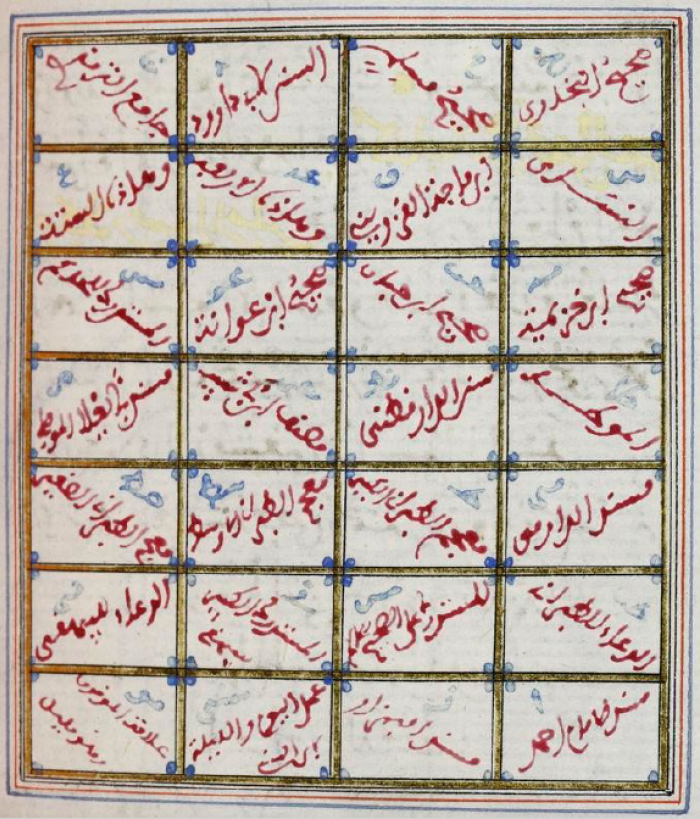

ʿUddat al-ḥiṣn al-ḥaṣīn was very popular and the production quality of different manuscripts varies, including the attention paid to marking the abbreviations to identify the hadith sources in the text. Most manuscripts inscribe the abbreviations in red ink after or before each hadith, whereas some calligraphically-embellished copies, such as Leiden Or. 14.076 in the viewer above, wrote the abbreviations more unobtrusively in superscript red ink above the beginnings of each hadith.
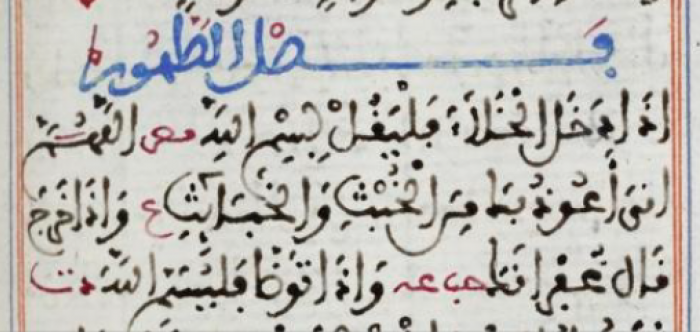
The table of abbreviations was also a place for potential embellishment. Whereas simple editions kept the abbreviations as text in the book's introduction, the Berlin copy illustrated above, originally from Tunisia, transforms the table and the text of the titles into patterns closely resembling local tilework designs. Another sumptuous North African copy created the table over two pages, cryptically weaving the letters of the collections into an aesthetic arabesque. The decoration is so dense, that identifying the abbreviation is somewhat difficult, and this copyist evidences that a handsome frontispiece was more pressing than a clear indication of the book's source authorities.
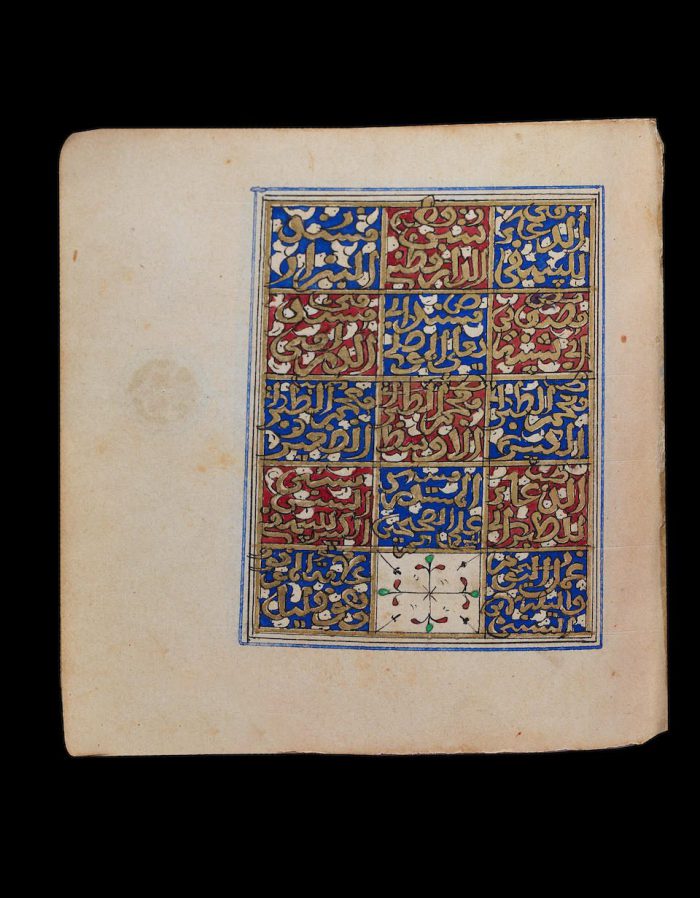
Ibn al-Jazarī’s method of indicating the source collection for each hadith naturally does not enable a studious reader to ponder the particularities of each isnād, and thus this method of marking authority would not be appropriate for scholars in a critical setting. Hadith manuscripts copied for studies, commentaries on hadith and other juridical manuscripts also do employ abbreviations, but the full array of ways in which scholarly texts graphically represent the isnād awaits further research. Concerning more informal contexts, the manuscripts of ʿUddat al-ḥiṣn al-ḥaṣīn reveal strategies for indicating textual authority in books of personal devotion.
More about this manuscript: lessons 20 and 23.
Further reading
The topic of the abbreviations and signs used in hadith, hadith commentary and juridical manuscripts has received attention in Arabic scholarship:
Māmakānī, Muḥammad Riḍā, Muʿjam al-rumūz wa-l-ishārāt. Beirut: Dār al-Muʾarrikh al-ʿArabī, 1992.
Al-Ẓufayrī, Maryam Muḥammad Ṣāliḥ, Muṣṭalahāt al-madhāhib al-fiqhiyya. Beirut: Dār Ibn Ḥazm, 2002.
Questions
-
Examine the table of sources and their abbreviations on f. 3v in Leiden Or. 14.076 (in the viewer). The table has 27 cells, but Ibn al-Jazarī drew his material from 25 books: which two cells do not mark hadith collections, and what do they connote?
-
Read the abbreviation key and look at the annotations on f. 10r of the Leiden manuscript Or. 14.076 in the frame. How many hadith are listed with how many sets of abbreviations? List the full names of collections from which each of the hadiths were derived.
Assignments
-
Find the opening page of Chapter 4 الباب الرابع: فيما يتعلق بالطهور والمسجد والأذان in the Leiden Ms. 14.076 in the frame above.
Look at Parts 2 and 3 of the chapter: the supplications to be made in the Mosque and the supplications to be made during the call to prayer (Adhān). Identify each hadith/supplication in both these parts and identify the sources as indicated by the abbreviations. Then compare them with the same passage in the Berlin Ms. Or. oct. 240 (ff.169v-170v).
There are some differences in the annotations: identify them and consider possible explanations for these differences.
